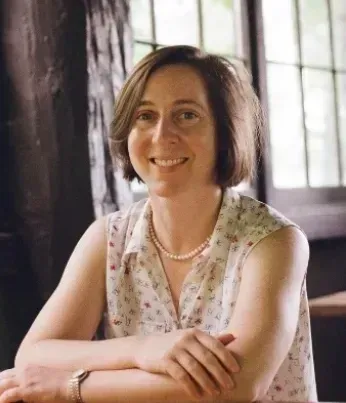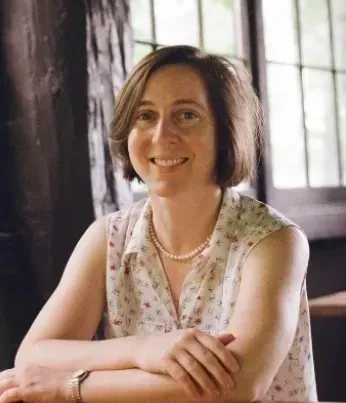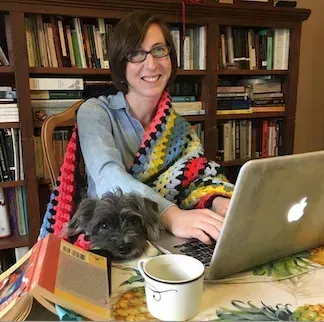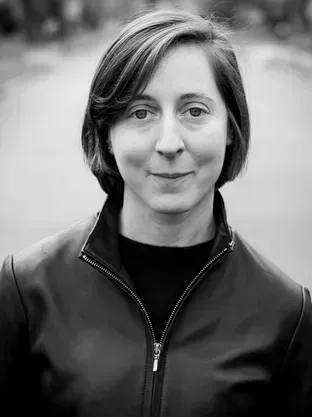
Jul 1
Words: poet Liza Flum on hovering between worlds
Michele Karlsberg READ TIME: 1 MIN.
In “Hover,” Liza Flum delivers a debut that bends light around grief, memory, and the quiet rupture of living. Her poems do not settle; they circle, lift, and linger in the liminal spaces between certainty and loss. This is a collection that insists on the value of attention and the resonance of absence.
Flum’s work has appeared in many publications. She is a recipient of a Barbara Deming artist grant. Her writing has been nurtured by fellowships from the Saltonstall Foundation, the Vermont Studio Center, Aspen Summer Words, and the Kimmel Harding Nelson Center.
With an MFA in poetry from Cornell University and a PhD in Literature and Creative Writing from the University of Utah, Flum enters the literary landscape with a voice at once finely tuned and fiercely original.
Flum discussed the genesis of “Hover,” the ethics of poetic attention, and what it means to write into the spaces we fear.

Michele Karlsberg: “Hover” explores queer polyamorous families with remarkable tenderness and complexity. What inspired you to begin writing this collection, and how did your own experiences shape its vision?
I started this collection because I needed a way to talk honestly about my life. It was during the first Trump administration; I was living in a conservative state, and, to be frank, I often felt scared to speak directly about queerness and polyamory, both personally and professionally. In this homophobic country, queer and polyamorous people are at risk of losing housing, employment, and of course, our basic safety, and polyamory is not a protected class.
Working on the project that would become “Hover,” I felt like I was writing my way out of the closet poem by poem. I needed room on the page to express what I wasn’t sure I could say plainly at my job, in the classroom, or to many of the people around me.
At the same time, writing Hover helped me to understand and build my most important relationships as they unfolded. I was in the process of forming a family with my partner and my metamour while writing the book, and the writing helped me understand what I wanted this life’s shape to be. I take seriously the idea that what we make space for on the page becomes what exists in the world. Art is visionary. I wasn’t just breaking a silence; I was conjuring a life into being.
I’ll also say that, as poets, we tend to be coy about the autobiographical content in our work. We insist on the “speaker” as separate from our identities. While there are limits to the truthfulness of any work, I want to acknowledge this book as essentially autobiographical to push back against closeting, for me and for anyone reading.

The book is rich with metaphor, especially the image of hummingbirds. What drew you to this particular creature as a symbol for the queer, chosen, and polyamorous family experience?
So many ideas in this book started as laughter. I felt a rush of giddy surprise when I thought about putting unlike things together: polyamory and hummingbirds. I had never seen them in the same sentence before! Whenever I find myself laughing over an idea, I know I have to write it.
But the hummingbird metaphor quickly became serious. It allowed me to think deeply about representation. When I was writing this book, I was looking around my life for artistic representations of other queer, polyamorous relationship structures, and I couldn’t find enough of them, even though I know these relationships are everywhere.
Statistics say that 20% of people have engaged in some form of nonmonogamy. Hummingbirds are all around us, but we see them only in glimpses and flashes. They move so quickly we almost can’t see them at all. Longing to see something that is nearly invisible because it’s of its life-force and vitality; that’s interesting to me.
You use multiple poetic forms, from sonnets to prose meditations and linked stanzas. How did you decide on these structures, and how do they reflect or embody the themes of fluidity and connection?
The poet Meg Day writes, “mastery of the sonnet (reading them, writing them) remains a steadfast and sometimes compulsory membership admission to participation in American poetics.”
I had this idea in mind –the sonnet as entry ticket– when I was writing the poems about polyamory and reproductive choice. Writing sonnets allowed me to dignify things like IVF and IUDs, and to assert that they deserve to be dead-center in American poetry. I also hoped the sonnet would smuggle this very intimate content into literature. Maybe the sonnet was a Trojan horse in this way.
As I got deeper into the sonnet cycles, I was thinking about the sonnet crown as an expression of interconnectivity. Because of their repeating first and last lines, each poem in a sonnet crown links with the poems it is surrounded by. I was struck by the ways my reproductive choices –to access assisted reproductive technology in the context of one relationship and to access birth control in the context of another– were like linked rooms in the same house, the same life. A stanza is a “little room;” these poems are intimate spaces and intimate choices, entwined.
Plus, when you’re writing a sonnet, you’re always counting. You count when you do IVF, too: days, weeks, and the number of embryos remaining. Writing a sonnet crown and doing IVF are both processes driven by limitations. Perhaps as a reaction, I wanted poems that broke constraints, too. The prose pieces in “Hover” sprawl across the page, an intentional, insistent way of transgressing boundaries and taking up space.

In many ways, “Hover” is about making visible what has been historically erased. How did you navigate the tension between visibility and privacy, especially when writing about intimate or medical spaces?
In “Memorial to a Marriage,” I describe how encountering a beautiful sculpture of two queer women makes the speaker of the poem feel represented and shielded at the same time. This wish –to be represented publicly without being dangerously exposed– is much of what steers the work. A lot of care and conversation went into what was revealed and what wasn’t revealed in this book.
On one hand, the poems are very open –there are moments that feel like overshares!– and on the other hand, I never wanted to make art that felt intrusive or violating. I quote my partners a number of times in these poems, and that is because the people I care about were involved in the conception and writing of this book. Maybe the difference between vulnerability and violation is a willingness to listen.
The collection doesn’t just describe love and family. It seems to enact them through its formal choices and emotional resonances. What do you hope readers carry with them after spending time in these “little rooms” of your poems?
I hope the poems will make people feel like their family, in whatever shape it takes, is valid. Like their lives and loves are seen. There’s a thing I called the “little lesbian nod;” when I’m walking with my partner and we pass another queer woman, we all give each other a tiny nod of recognition. I hope the book can be someone’s lesbian nod: something that makes us all smile and feel less alone as we continue on our way.
The book is really aimed at people who share my experience and context, but other readers are welcome too. So, for anyone unfamiliar with queer love, polyamory, or chosen family, I hope the book invites solidarity and even delight at the beauty of these things.
As someone living and writing within queer and polyamorous community, what conversations do you hope “Hover” might spark, among readers, writers, or even within families themselves?
The issues the book explores are politically urgent, and they deserve to be talked about; argued over, even! Why would queer people get married? Why wouldn’t we get married? Who is included and who is still excluded from the institution of marriage, anyway? The logistics and politics of accessing birth control and IVF are gnarly. We need to talk about the financially extractive medical systems and sadistic policies that make those choices inaccessible for so many of us.
I hope that the work makes some people uncomfortable and also makes some people laugh. But most of all, I’ve had people approach me to share that Hover made them feel validated in their sexuality or relationships. That was my quiet hope while I was writing: that someone might read the book and feel a little less isolated, and maybe even a little more brave.
Michele Karlsberg Marketing and Management specializes in publicity and marketing for the LGBTQ+ community. This year, Karlsberg celebrates 36 years of successful campaigns. www.michelekarlsberg.com

